Destroying Angel
A beautiful but deadly mushroom causing the same symptoms as Amanita phalloides. Fairly rare.
| Mushroom Type | |
| Common Names | Destroying Angel (EN), Angel Angau (CY), Muchomor Jadowity (PL), Hegyeskalapú Galóca (HU) |
| Scientific Name | Amanita virosa |
| Season Start | Jul |
| Season End | Nov |
| Average Mushroom height (CM) | 10-14 |
| Average Cap width (CM) | 7-11 |
Cap
7-11 cm. Convex then conical to almost flat but usually retaining an umbo. The cap is pure white and can be viscid.
Stem
10-14 cm long, 1-1.5 cm diameter. White with a fibrous skin. As with other Amanitas the stem starts from a bulbous volva but the skirt is fragile and often missing or slight.
Spore Print
White. Globose.
Taste / Smell
DO NOT try any of this mushroom.
Frequency
Fairly rare.
Other Facts
The symptoms of Destroying Angel poisoning can start several hours after ingestion with severe vomiting, diarrhoea and abdominal pains and can last for a few days; this is followed by what seems to be a recovery for a few days but ending in death from kidney and liver failure. The main poison, alpha-amanitin, kills liver cells and passes through the kidneys to be recirculated and cause more damage.
There are things that can be done to try and mitigate any harm from ingestion of the Destroying Angel while on the way to hospital. Excessive hydration with water can be very helpful as soon as possible. In hospital they can now sometimes treat the poisoning using an extract of milkthistle, if not, dialysis followed by new kidneys and possibly liver is the only option.

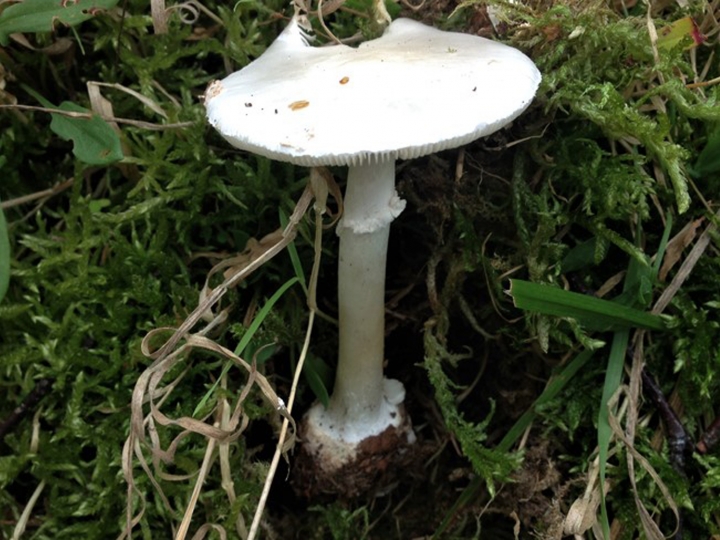















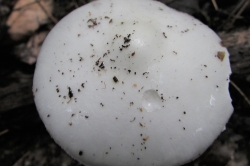
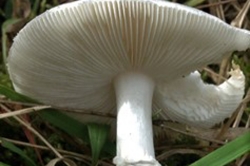
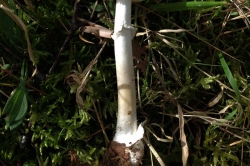
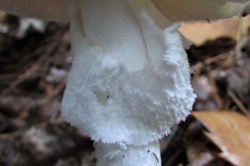
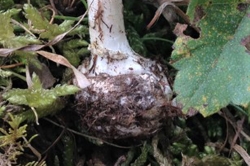
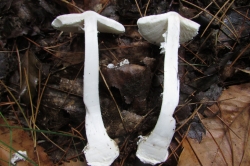
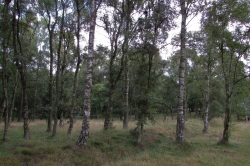






16 comments for Destroying Angel
This deadly mushroom is locally abundant and common in some parts of Scotland. Please take care.
Does this mushroom ever grow on grassland, or is it a forest species only? I found something similar on a rugby pitch, which at first I thought was a young horse mushroom.
They grow in association with trees but there are several look-a-likes including the Leucoagaricus leucothites which I have found in grassland.
Salutary lesson. The sheer beauty of these lily white mushrooms, the absence of a giveaway smell, indeed a pleasant ‘mushroomy’ aroma, and their ‘peelability’ (often cited as a test of edible mushrooms) conceal the fact that half of one of these can be deadly to an adult. The potent toxins are not denatured by cooking, they recirculate in our systems, and some authorities advocate not touching the mushrooms at all. But the ‘lesson’ is that I have a handsome crop on my Wiltshire lawn, right outside the kitchen. And not two feet from a patch of common field mushrooms. Which shortly after recent rain, warmth, and rapid growth the Destroying Angel’s various forms too easily resemble, to a careless hand (I would have liked to attach a cautionary pic). And the course of inadvertent poisoning is as insidious as it is reliably terminal, if not treated in hospital within 36 hours, and then possibly only with a liver transplant. Very glad I looked into it! At the risk of engendering uncalled for self-confidence (or worse) the potential lethality of these things merits wider recognition.
Have some also on a lawn in Wiltshire – what is best way to dispose of them ???
I’m not sure how to get rid of them permanently, fungicides can damage the ecosystem of your garden. Place them in a bag and put them in your landfill bin to dispose of them.
Found two suspected specimens of today in my polytunnel. Some of the soil in my raised beds was taken from wooded areas of our land and we use home-grown Hazel twigs as plant supports. That’s the only explanation I have for how they got in there. Someone else helped me ID them and I’m really hoping they are actually Leucoagaricus leucothites…
There were absolutely loads of these in mid Norfolk today. We thought the smell was faintly unpleasant.
We have tons of these in oak and hemlock woods in Northeastern United States in August which I call Amanita month for all the abundance of amanitas species then. Beautiful to behold, gives one a shiver but they are good for the trees they live with.
Had several of these last year. Be warned, our next door neighbour’s dogs were very ill and one died for no apparent reason. They then found these in their grass and suspect the dogs had ‘investigated’ them with the resulting consequences
I found lots of these at the local park coming up through the fallen leaves. They were so pretty I had to look closer and having no knowledge of mushrooms picked one to look at it. They were alongside the kids play park and I guess I wanted to see if they were edible. Total shock to read how deadly these mushrooms growing in my local park are. Hoping that picking them doesn’t have any side effects either!
Hope you are still alive! I just picked one to identify it and sniffed it, poked at it and touched my nose with it. Had its juices on me for a good 5 minutes before I realised what it was. I have 8 of them among my broccoli plants. Must have come from the compost I used. I am paranoid now,
I have just found some in a pot of Brugmansia which are growing well in my greenhouse.
They are in compost which may explain how they came here.
Never eat any mushroom with white gills unless you know what you’re doing and you’ll not eat a nasty Amanita. Always told to never eat a foraged mushroom with white gills. Can’t go far wrong with that simple advice. If you’re starting out just find the 5 or so easily identified safe mushrooms! You can increase your knowledge slowly thereafter!
I ate one nearly a year and a half ago and was the sickest I’ve ever been…not sure what damage has been done…only time will tell …it was a large one out of the twelve or so I picked
found a fairy 🧚♀️ ring of Angel mushrooms in my lawn near the car shed.
pretty to look at??NSW AUSTRALIA 🇦🇺